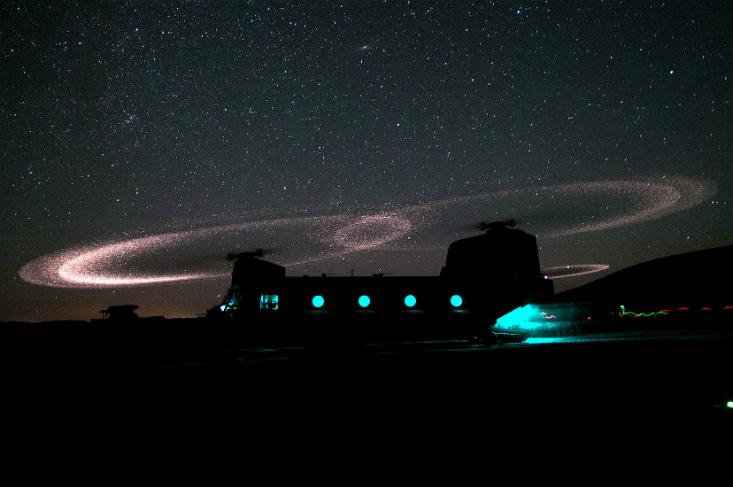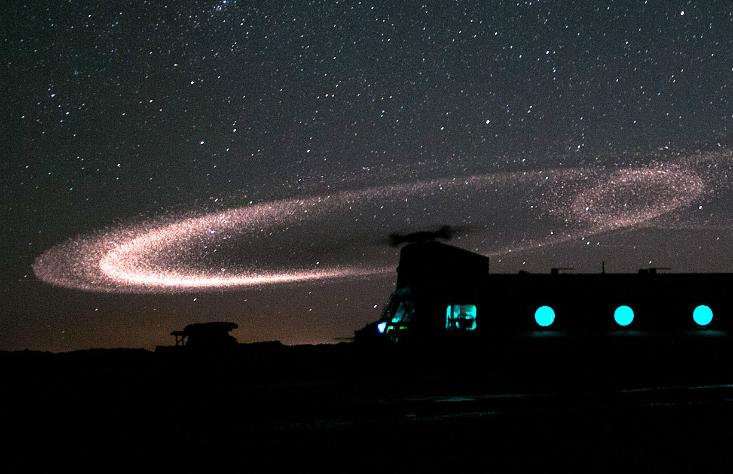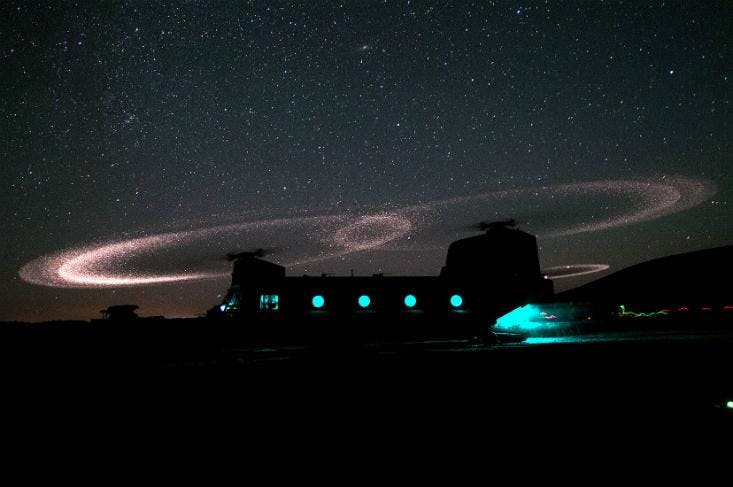
One of the most beautiful things you’ll ever see in a war zone had no name, until it was given one in honor of two soldiers who gave their lives.
Benjamin Kopp, a US Army Ranger, and Joseph Etchells, a British soldier, were killed in combat in Sangin, Afghanistan, before they were old enough to easily rent a car. Each of them had probably seen what happens when a helicopter descends into a sandy haze before; they had most likely ridden in one that was producing the show of curious physics. Thanks to one photographer, their names now adorn the dazzling effect produced by helicopter blades hitting sand and dust. If the conditions are just right, you’ll see three halos on a military helicopter—the Kopp-Etchells Effect.
In 2009, war correspondent Michael Yon gave the physics of helicopter halos its name to honor the two soldiers who were killed in combat in July of that year. Documenting helicopters descending in Afghanistan, he took dozens of photos showing glowing halos imposed on the helicopter’s blades like spiral galaxies. Nobody knew what the halos were. The helicopter pilots had their own theories. Yon describes speaking to one pilot who said the halos were “a result of static electricity created by friction as materials of dissimilar material strike against each other.” On forums and message boards there were other ideas. Some believed that the extreme speed of the helicopter blades was pushing dust out of the way so fast that it burned up like meteors in the atmosphere.
Both theories have problems. A static discharge looks nothing like a shower of sparks and blades going fast enough to heat particles in the air around them would heat up themselves. Without any published research to go on, the most likely theory is one that matches the physical phenomenon and explains others. If they had been Boy Scouts, Benjamin Kopp and Joseph Etchells might have known already.
When a helicopter descends into a sandy environment, the enormous downward thrust from the blades inevitably kicks up a cloud of sand. Cutting through the sand and dust, the blades smash into millions of these tiny particles, each sandblasting metal from the blade. Most of the time the only visible consequence to the helicopter is pitting on the blades, with enough damage warranting replacement. Every so often, however, the metal blasted from the blades produces a miniature meteor shower.

To prevent early degradation, most helicopter blades are coated with an abrasion strip. This strip, typically made of a metal like titanium or nickel, prevents the leading edge of the blade from being worn down too quickly by the various particulate hazards of the atmosphere. This abrasion strip can handle a lot of wear and tear, but the desert is a harsh environment. Sand is harder than the titanium or nickel that makes up the abrasion strip, so when a helicopter’s blades begin cutting through a cloud of sand, the particles hit the blades and send bits of metal flying into the air.
It turns out that the metals comprising the abrasion strips on helicopter blades can be pyrophoric—they can spontaneously ignite in air. But of course this doesn’t happen in normal circumstances; we don’t see bricks of nickel bursting into flames. Rather, the spinning blades of the helicopter generate a cloud of metal particles. Once in that form, the metal particles can ignite and light up. Like sawdust or flour, finely powered metal can and does explode.
We are all familiar with the pyrophoricity of metals, even if we don’t know it. Think of a metal that when struck creates a spark, like a dilapidated car dragging a sparking muffler along the road. The sparks that we see are in fact small metal particles being dispersed into the air by some impact and then igniting. And if you have ever started a fire with a flint (or even a regular cigarette lighter), or used a bench grinder to work on metal, you know exactly what this looks like.
Engineers would agree about the source of helicopter sparks. Put a metal that conducts electricity but is resistant to oxidation—that is, one that’s not pyrophoric—in a supersonic test chamber like they have at NASA’s Glenn Research Center, and there is no Kopp-Etchells effect. The result shows that it’s not statis discharge that causes the rotor lights.
With a tired face partially illuminated by the unusual light emanating from helicopter rotors, maybe a soldier can for a moment escape from a harsh, gritty world to one filled with wonder and beauty. The vehicle that brought Kopp and Etchells to that harsh place also showed them a window into that world of beauty. Thanks to the amazment photos showing their effect will always bring, Kopp and Etchells will live on in the hearts of their families and the annals of physics.
Kyle Hill is a freelance science writer and blogger for Scientific American who has contributed to Slate, Wired, Popular Science, Skeptical Inquirer, and io9. He is a research fellow with the James Randi Educational Foundation, and you can follow him on Twitter under @Sci_Phile.



